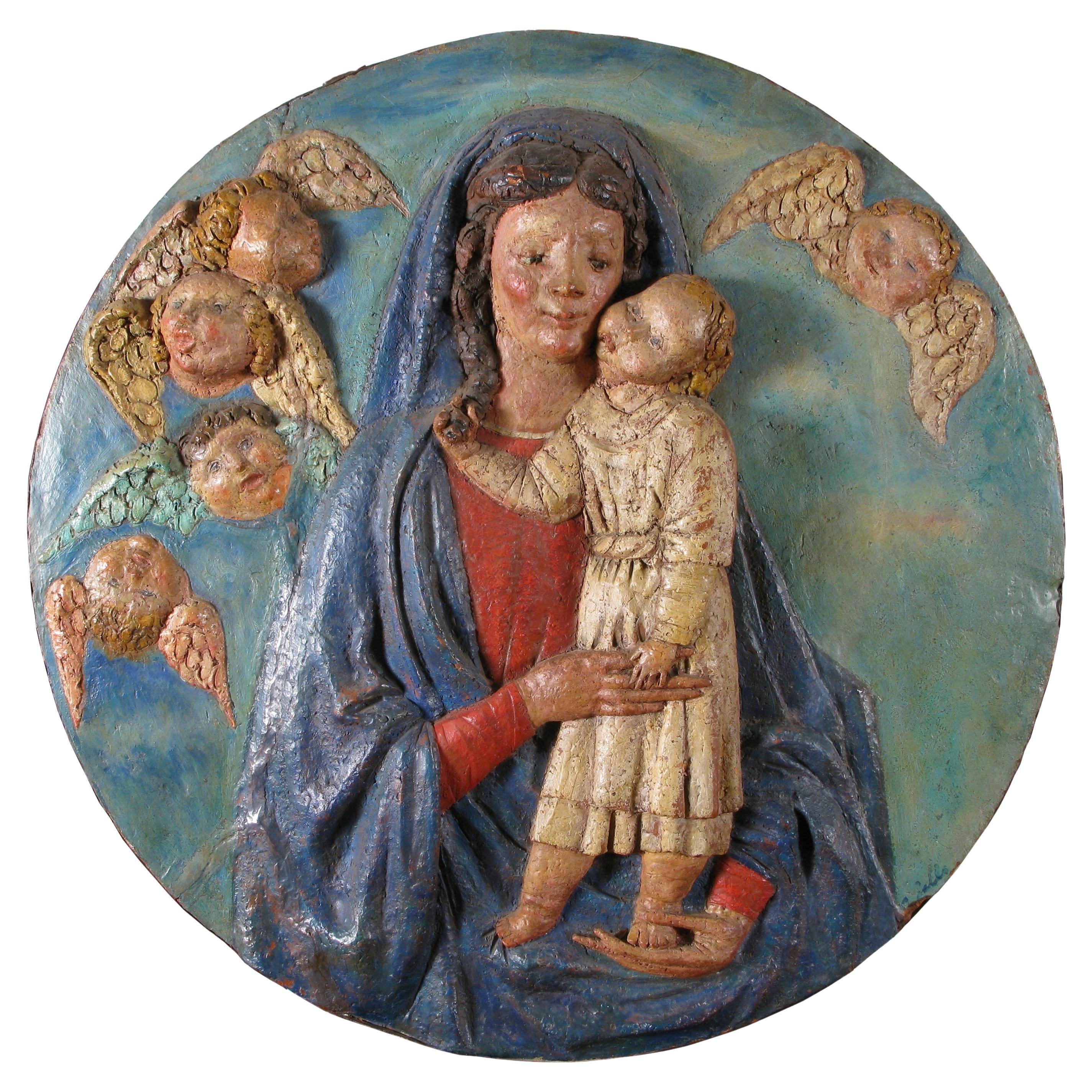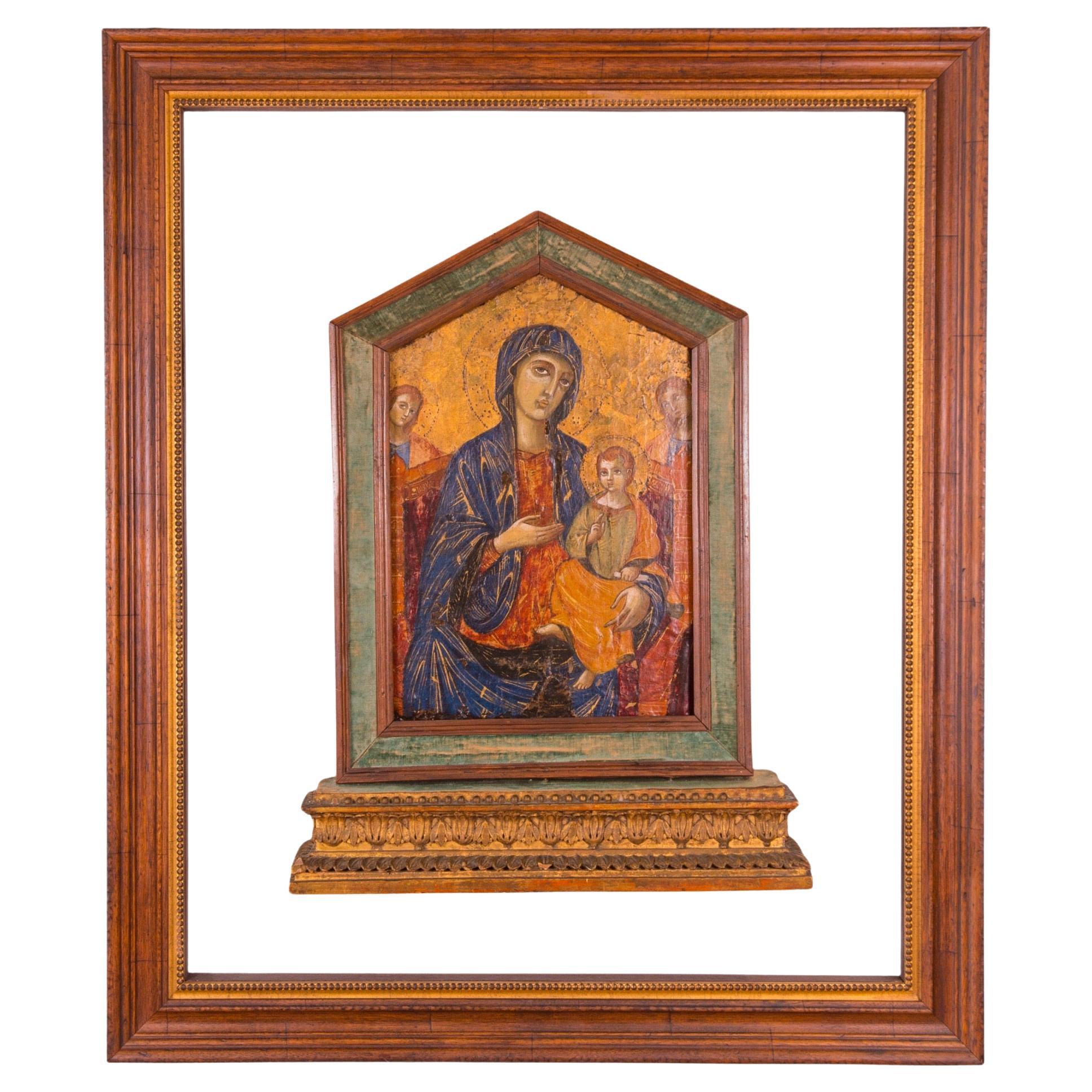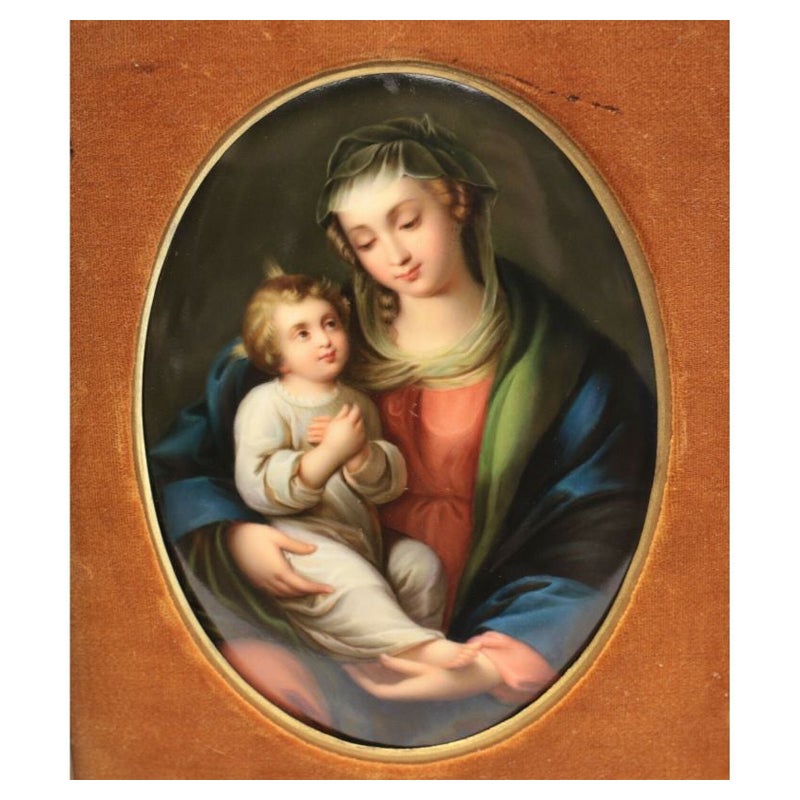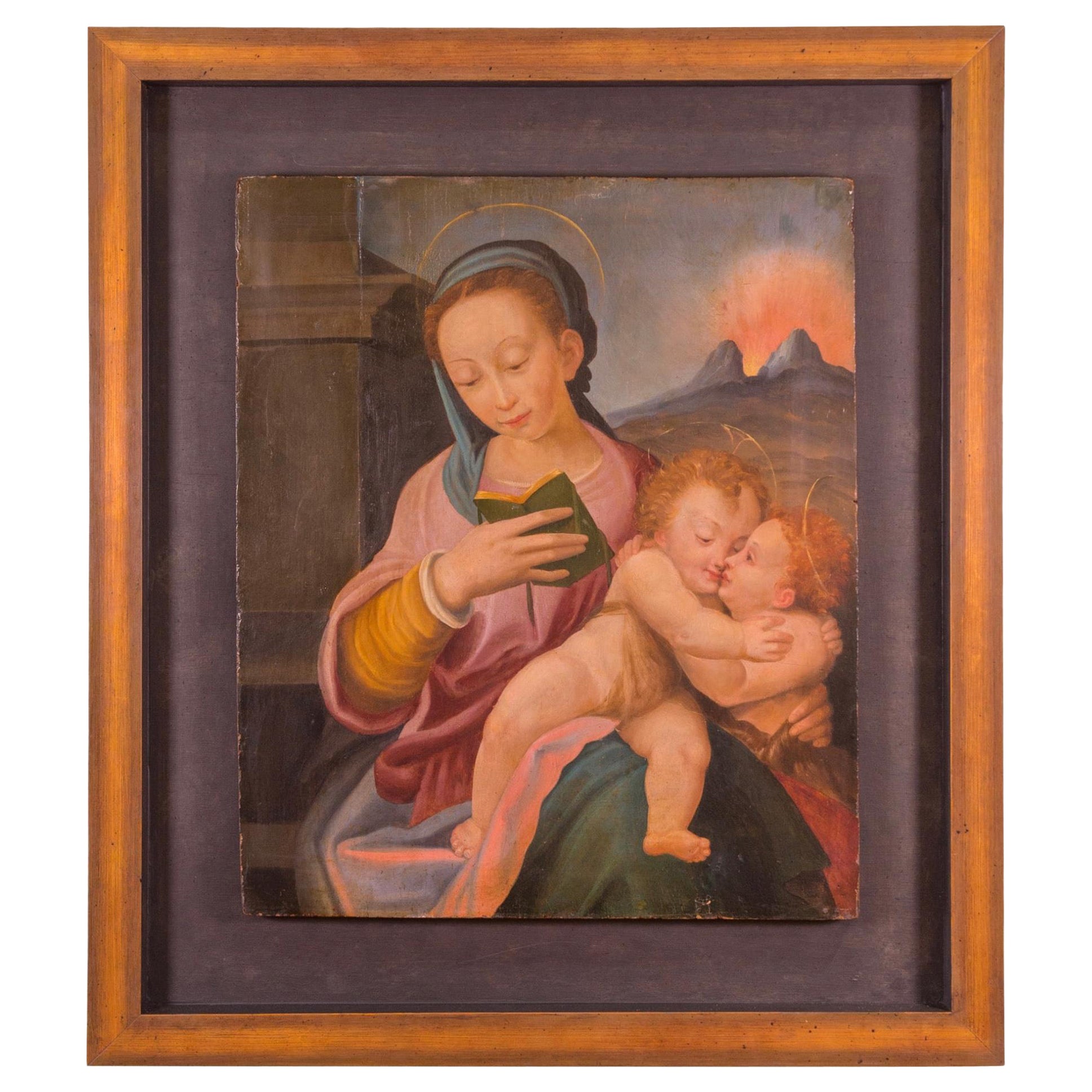Items Similar to Attributed to Domenico di Paris - Madonna and The Child, 15th century
Want more images or videos?
Request additional images or videos from the seller
1 of 6
Attributed to Domenico di Paris - Madonna and The Child, 15th century
About the Item
Attributed to Domenico di Paris, also called Domenico del Cavallo ( Monselice, documented in Ferrara between 1442 and 1501)
Madonna and The Child
Polychromed and gilded Stucco
47,5 x 37,5 cm
Exhibitions :
- Il tesoro d’Italia, a cura di Vittorio Sgarbi, Expo 2015, 22 maggio-31 ottobre 2015, Silvana Editoriale, pp. 162-163, Emilia n. 4
Modeled in half-length, The virgin, tenderly holding her Son, raise from an angel’s head, against a blue starry background.
The Child is clutching his mother’s veil with one hand, his other at her back. The Mary’s thick mantle and robe and lighter veil envelop her and offer protection to the Child, who entwines the veil with his hands.
This Madonna is portrayed with pleasing, youthful features; she tenderly support the Child Jesus and lightly cradles His foot which she holds between two fingers; a graceful, touching iconographic invention.
The artist was clearly interested in a naturalistic rendering of the subject as seen in the painted details of the hair and faces and the careful modeling of the drapery.
The outstanding original fifteenth-century polychrome rendition is the most fascinating element of this haut-relief in stucco. The highly refined painterly details are rendered with touching graphic skill, as in the facial features and in the refined decoration of the Virgin’s veil and the clothes of the Child as in the angel’s wings. This elegant relief is quintessential example of works that Renaissance Italian artists produced for domestic devotion.
So popular were images of the Madonna and Child that artists sought to vary and polish their composition. It is a forceful representation of the subject, but two very different qualities, intimacy and modest scale, are what make this kind of relief so successful.
This stucco shows an intimate and beautiful composition, a peculiar domestic feel, an appealing naturalism that suggest it was inspired by an illustrious model; the mastery of the technique indicate an artist familiar with the refined elegance of Tuscans workshops.
The iconography of the Madonna holding Christ’s foot and of Christ grasping his mother’s veil, popular in Renaissance Italian panel painting as well as sculpture, derives from Byzantine icons. But it appears that Luca della Robbia have first essayed the half-length Madonna holding a Child in a work in stucco (Musée Jacquemart-André, Paris) about 1430. With regard to the molding, as Enzo Carli pointed out, it is of a model retraceable to a well-known typology, diffused through numerous replicas made both by the master himself and others, of the Corsini Madonna by Luca della Robbia, dateable to the fifth or sixth decade of the fifteenth century.
Especially the impetus and quick manners of the Child, that bear witness to the as yet fresh experiences of Masaccio and Donatello, confirms that this stucco may be inspired by Luca Della Robbia prototype.
The back of this stucco is solid and flat as the Friedrichstein Virgin, cast from the same mold, of the Virgin and Child in a Niche, of the type known as the “Bliss Madonna”: these are in the Metropolitan Museum of Art, New York and in the Museum of Fine Arts, Boston, and are also datable to the same period.
The Buffalo Virgin, which is distinguished by more detailed modeling, more accurate technical execution (see, for example, the way that the back of the panel is finished with chamfered edges to the borders) and a more delicate palette in the glazing, could be an entirely autograph work (its high quality and its claim to this status has been endorsed by Avery 1976 and Pope-Hennessy 1980, after seeing it with their own eyes in April 1976), while the Berlin version could be a replica delegated to an assistant – such as Luca’s young nephew Andrea della Robbia (Florence 1435 - 1525), who was documented as working in Luca’s studio from 1451 onwards. Alternatively, acknowledging the initial experimental phase of Della Robbian art, it might be that the Buffalo Virgin was executed by Luca some time later, with a perfected technique and revisions to some of the details of the modelling. However, it is not impossible that different destinations may have accounted for such variations. Nevertheless, there can be no doubt about Luca’s responsibility for this touching model, which clearly demonstrates the “familiar, pleasing, but suspended and silent humanity” that distinguishes the master’s best work towards the middle of the century.
« L’accentuata toscanità » (The accentuated Tuscan character) of our stucco relief indicate that the author was familiar with the iconographical innovations proposed in Florence; meanwhile this stucco shows some significant affinities, especially in the polychromy, with the refined artistic atmosphere of the este court.
As Giancarlo Gentilini first suggested this work could be by the hand of an artist active in Ferrara as Antonio di Cristoforo (Gentilini, 2008). In fact The centres north of the Arno, in which plastic art were practiced, were Bologna and Padua, the latter being the town in which Donatello, during a sojourn lasting over ten years, succeeded in firmly establishing the tradition of the Florentines. The restricted circle of pupils and other collaborators adapted Donatello’s style in a more or less successful personal manner, and so established it in many provinces, both in the immediate neighborhood of Padua and further afield. Ferrara, a close neighbor of Padua, naturally could not remain independent of the effect of the great Florentine’s long years of work in the vicinity. Although very few sculptures dating from the first decades of the century have been brought to light in the city of Este, too few to give any clear impression of the existence of a native school of carvers, from the beginning of the ‘forties we are confronted with one tangible personality bearing the name of Niccoló Baroncelli. This artist was a native of Florence and, according to Vasari, had been a pupil of Brunelleschi. His existing works indicate a long apprenticeship with Donatello.
Baroncelli, who, through his engagement in the service of the Estensian Court, remained in Ferrara till his death in 1453, must have been an active worker, but unfortunately, the greater part of his work has been lost. We found evidence in them of the extent to which his gifted pupil and son-in-law, Domenico di Paris, a Padouan by birth, obtained his artistic education from him. Domenico, documente as « maestro de figure de terra et de metallo » (maître des sculptures en terre-cuite et métal) played a leading part in Ferrarese sculpture during the second half of 15th century. Born in Monselice, he was formed in Padua, where he familiarized with the works of Donatello. Around 1442 Domenico di Paris is documented In Ferrara, together with his brother in law, the Florentine sculptor Niccoló Baroncelli who had been invited to the city to create the equestrian monument of Borso d’Este (destroyed in 1796) and a set of five bronze sculptures for the cathedral. After Baroncelli’s death in 1453, Domenico completed all the commissions. In 1467 Domenico was engaged as « intarsiator lignaminis » in the execution of the ceiling of the « Camera Superioris » of palazzo Schifanoia.
The major ducal commissions of bronze monuments in honor of Niccoló III (1443-1451) and Corso (1451_1457) brought three artists to Ferrara that « combined the Florence of the humanists and the Padua of the antiquarians, profoundly influencing Ferrarese art in the direction of Donatello: Antonio di Cristoforo, Niccoló Baroncelli and Domenico di Paris » (cit. permanent exhibition in the recently re-opened Palazzo Schifanoia, 2020).
In the present relief representing the Virgin and the Child, the influence of the Paduan works of Donatello is filtered by a softer vision partly indebted to Florentine models; the style is far from the expressionist irregularities of his contemporaries working in Ferrara.
A very similar relief from the Dogliani Collection, of inferior quality, show the same composition of our relief. Dated 1480, this timeline is indicative of the production of our stucco as well.
The decorative finesse, the richness of the polychrome and the naturalistic attention of this Virgin and The Child show affinities with the Virtues of the Stucco room in Schifanoia, last documented work of Domenico di Paris.
The accentuated tuscan character and the stylistic affinities with the reliefs in Palazzo Schifanoia, as also the remarkable similarities with some sculptures attributed to Baroncelli, led the art historian Paola Ranzolin to attribute this work to Domenico di Paris and to publish it in the exhibition curated by Vittorio Sgarbi in 2015 (International expo - « Il Tesoro d’Italia ») where a selection of treasures of the Italian artistic patrimoine were presented according to a regional approach aimed to enhancing the richness and individuality of the different provinces of the Peninsula. This stucco is one of the 27 works selected to represent the evolution of the rich artistic heritage of Emilia Romagna.
- Dimensions:Height: 18.71 in (47.5 cm)Width: 14.77 in (37.5 cm)Depth: 1.19 in (3 cm)
- Style:Renaissance (Of the Period)
- Materials and Techniques:Stucco,Polychromed
- Place of Origin:
- Period:
- Date of Manufacture:15th century
- Condition:Wear consistent with age and use.
- Seller Location:Bruxelles, BE
- Reference Number:1stDibs: LU6666239212722
About the Seller
5.0
Vetted Seller
These experienced sellers undergo a comprehensive evaluation by our team of in-house experts.
1stDibs seller since 2022
6 sales on 1stDibs
Typical response time: 7 hours
- ShippingRetrieving quote...Ships From: Bruxelles, Belgium
- Return PolicyA return for this item may be initiated within 3 days of delivery.
More From This SellerView All
- Ecce Homo - Florence, 15th centuryLocated in Bruxelles, BEA terracotta bust "Ecce Homo" Florence, 15th century 53 x 44 x 31 cmCategory
Antique 15th Century and Earlier Italian Renaissance Figurative Sculptures
MaterialsTerracotta
- Adoration of the Magi, Flanders, 17th CenturyLocated in Bruxelles, BEThe Adoration of the Magi. Panel carved in high relief. Flanders, 17th century. Measures: 53 x 32,5 cm.Category
Antique 17th Century Dutch Renaissance Figurative Sculptures
MaterialsWood
- Massacre of the Innocents, Normandy, Late 16th CenturyLocated in Bruxelles, BEThe Massacre of the Innocents Carved oak panel Normandy, late 16th century (Collection labels on the back) Measures: 43,5 x 61 cm.Category
Antique 16th Century French Renaissance Wall-mounted Sculptures
MaterialsOak
- Terracotta Bust of Christ as the Redeemer, 15th CenturyLocated in Bruxelles, BEA terracotta bust of Christ as The Redeemer Tuscany or Emilia Romagna, late 15th century Measures: 46 x 43 x 21 cm This powerful, moving bust of...Category
Antique 15th Century and Earlier Italian Renaissance Figurative Sculptures
MaterialsTerracotta
- Gothic Canopy, France, 15th CenturyLocated in Bruxelles, BEGothic canopy France, 15th century Alabaster, some traces of polychromy 33 x 23 x 20 cm Provenance: - Private collection Genève, Switzerland ...Category
Antique 15th Century and Earlier French Gothic Figurative Sculptures
MaterialsAlabaster
- Embriachi workshop marquetry casket - Northern Italy, 15th centuryLocated in Bruxelles, BEEmbriachi workshop marquetry casket Northern Italy, 15th century Alla certosina inlays (bone, stained bone, pewter and wood) H 28.2 x W 18 x D 14 cm This beautiful casket of rectangular form is richly decorated with the characteristic geometric patterns of the Embriachi style. The intricate geometric patterns are fashioned by juxtaposing lighter and darker pieces of wood, (colored) bone, horn and pewter. The lid and base are framed by a broad band of horn. When ivory became scarce in Europe due to disrupted trade routes, bone was substituted. The attention to Symmetry and balance created an harmonious visual effect Enhancing the overall aesthetic appeal of the casket. The application of geometrical motifs is in Italy known as marquetry ‘alla Certosina’, named after the Certosina Church in Pavia with its famous altarpiece decorated in this way. This is ‘intarsia technique’, a term derived from the Arabic 'tarsi', which means ‘incrustation' recalling ancient mosaics made from various materials. These geometric elements not only enhance the aesthetic appeal of the caskets but also demonstrate the versatility and skill of the artisans in creating multifaceted works of art. ‘Alla Certosina’ became famous through the Northern Italian Embriachi family who achieved a particularly high standard in working in this technique. Venice in particular was known for the production of these luxurious boxes. The caskets, hexagonal or rectangular, surmounted by a lid decorated in several registers constitute the secular, albeit equally renowned component of the workshop’s production, in addition to mirror frames and various everyday objects. The method of fabrication of those objects was based on two concepts that underlay pre-industrial production: standardization and modularity, thanks to a distribution of skills according to the different phases of fabrication. even the realization of the marquetry motifs (in the form of ingots from which portions of the desired size were cut) were therefore entrusted to various specialized craftsmen, as were the assembly phase. Today better known thanks to the extensive research work recently carried out by Michele Tomasi, this workshop owes its name to its founder and owner, the Florentine Baldassare Ubriachi (or degli Embriachi), a merchant and banker established in the Tuscan capital before he settled in Venice in 1395. Together with sculptor Giovanni di Jacopo, who directed the workshop, from the last years of the fourteenth century, Baldassare oversaw a production that was truly original, and still easily recognizable today, comprising monumental altarpieces and various objects, primarily triptychs and caskets. The precise location of the workshop is unknown, except that it originated in Florence and in ca. 1431 there was apparently a workshop in Venice, in the area of S Luca. They employed local workers specializing in 'certosina' (inlay of stained woods, bone and horn), and the workshop produced items carved in bone (usually horse or ox) with wood and bone marquetry. The geometric decoration of Embriachi caskets reflects the artistic complexity and attention to detail that characterized their work. this inlaid casket is a testament to the skill and artistry of the Embriachi family and serves as a stunning example of the decorative arts of the late Middle Ages. Related Literature : E. Berger, Prunk-Kassetten: Europäischen Meisterwerke aus acht Jahrhunderten / Ornamental Caskets...Category
Antique 15th Century and Earlier Italian Renaissance Decorative Boxes
MaterialsPewter
You May Also Like
- Madonna with Child, Tondo in Polychrome Terracotta from the 20th CenturyLocated in Brescia, ITMadonna with Child, tondo in polychrome terracotta from the 20th century Round polychrome terracotta sculpture depicting the Madonna and Child On a blue background, representing ...Category
Vintage 1940s Italian Renaissance Wall-mounted Sculptures
MaterialsTerracotta
- Madonna Enthroned with the Child Christ, 17th Century, Gold Gilded on Wood PanelLocated in North Miami, FL17th Century Italian polychromed and gold gilded on wood panel Sienese style painting of the Madonna Enthroned with the child and two adoring angels behind them. The halos are beautifully adorned with punch work. She is framed by a hand-carved gold gilded and velvet lined frame and sitting on a hand-carved matching base. The piece is mounted on a Lucite panel and framed with a contemporary hand-finished wood molding.Category
Antique Early 17th Century Italian Renaissance Wall-mounted Sculptures
MaterialsGold Leaf
- KPM Hand Painted Porcelain Plaque - Madonna & Child, 19th CenturyLocated in Gardena, CAKPM Hand Painted Porcelain Plaque - Madonna & Child, 19th Century A beautiful hand painted oval KPM plaque of Madonna & Child, 19th Century. Framed and matted in a velvet gilt wood frame. KPM mark...Category
Antique 19th Century Wall-mounted Sculptures
MaterialsPorcelain
- The Madonna with Christ Child and the Infant St. John the Baptist, Hand PaintedLocated in North Miami, FLLate 16th century Italian school oil on a wood panel painting of The Madonna with Christ Child and the infant St. John the Baptist. Mount Vesuvius is erupting in the background. This painting was part of the collection of Fred B...Category
Antique 16th Century Italian Wall-mounted Sculptures
MaterialsWood
- Large German Painted Porcelain Plaque of Madonna & Child, 19th CenturyBy Königliche Porzellan-Manufaktur (KPM)Located in Gardena, CALarge German painted porcelain plaque of madonna & child, 19th century. The large oval plaque is possibly artist signed by "FR Hill Dresden" to the lower edge. Mounted to a large ...Category
Antique 19th Century German Wall-mounted Sculptures
MaterialsPorcelain
- Mid-Century Virgin to the Child Enamelled Plaque, French, circa 1960Located in Labrit, LandesVirgin Mary and Baby Jesus enameled wall plaque. French, mid-century. Reproduction from a stained glass window of Reims cathedral (13th century) ...Category
Mid-20th Century French Mid-Century Modern Religious Items
MaterialsEnamel





